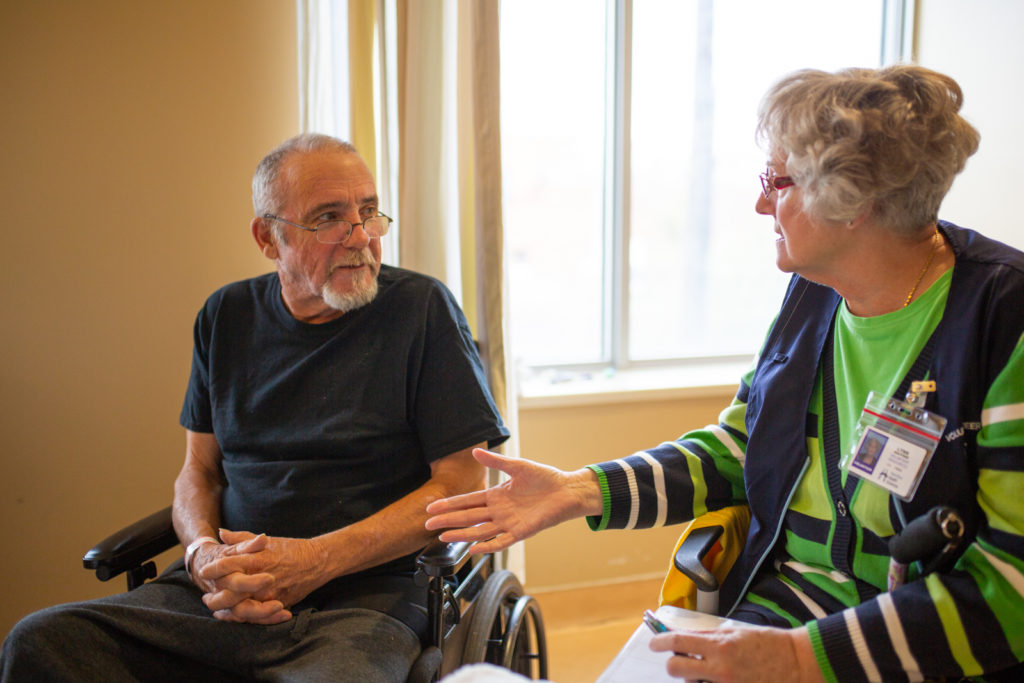
Stroke survivor is here to listen
Lynn Gauthier suffered a stroke just a few years ago. It was a trying experience she hopes she’ll never encounter again.
She saw an opportunity, though, to help others in need. Using her experience as a stroke survivor, Lynn volunteers in Hamilton Health Sciences’ (HHS) stroke rehabilitation unit to talk to new survivors about their experience in recovery.
Through a partnership with March of Dimes Canada, Lynn spends a couple hours every week visiting with patients who recently suffered a stroke. The program is called Peers Fostering Hope.
“I ask them about their families and where they live, really try to get to know them,” says Lynn. “We talk about the pictures on the wall or what’s on TV.”
The introduction helps patients get more comfortable with Lynn and they look forward to those weekly conversations.
Peers Fostering Hope increases confidence
The Peers Fostering Hope program in Hamilton launched earlier this year. It was modelled after the Linking Survivors with Survivors program, which began 10 years ago in the Waterloo-Wellington region.
The goal is to enhance the patient experience while recovering from a major life event. It also helps patients feel less isolated by connecting with someone who’s been through a similar medical issue.
“I think everyone wishes there was someone who can connect on their level after a medical event.”
An increase in confidence and the knowledge of survivors re-engaging in the community are big factors in a patient’s recovery.
Volunteers can also make referrals to staff based on their observations.
Though Lynn speaks highly of her care team while she recovered from her own stroke, she wishes there was someone who could connect with her the way she’s able to connect with new stroke survivors.
“I think everyone wishes there was someone who can connect on their level after a medical event,” says Lynn.
“Someone to tell you it’s okay to have a bad day, and that you need to allow your brain time to recover. I try to help them come to those terms.”
Former stroke patient now part of the team
Lynn believes her work is making a difference on the unit. Staff in the program agree.
“Engaging past persons with stroke to lend support to new persons with stroke builds our community capacity and raises us to new standards of excellence,” says Jennifer Robinson, clinical manager for the stroke rehabilitation unit at HHS’ Regional Rehabilitation Centre at Hamilton General Hospital.
“Having Lynn in the room helped him to see what life is like on the other side of recovery.”
“I thought this was something we should definitely make available to our patients.”
One patient, Jennifer says, envisioned his life outside the hospital for the first time.
“Having Lynn in the room helped him to see what life is like on the other side of recovery,” adds Jennifer. “I know she feels pride and satisfaction in what she’s doing for our patients. She’s a great addition to the team.”
“I am so happy I became a volunteer for stroke rehabilitation patients,” adds Lynn. “Meeting them all gives me such joy and has brought meaning to my life. I look forward to Wednesdays.”
More than 30 volunteers like Lynn involved in Peers Fostering Hope contributed over 2,500 hours last year at 21 hospitals.
The partnership with March of Dimes Canada is also supported by the Dr. Ed & Bobby Yielding Fund, Ipsen Canada and the Central South Regional Stroke Network.
